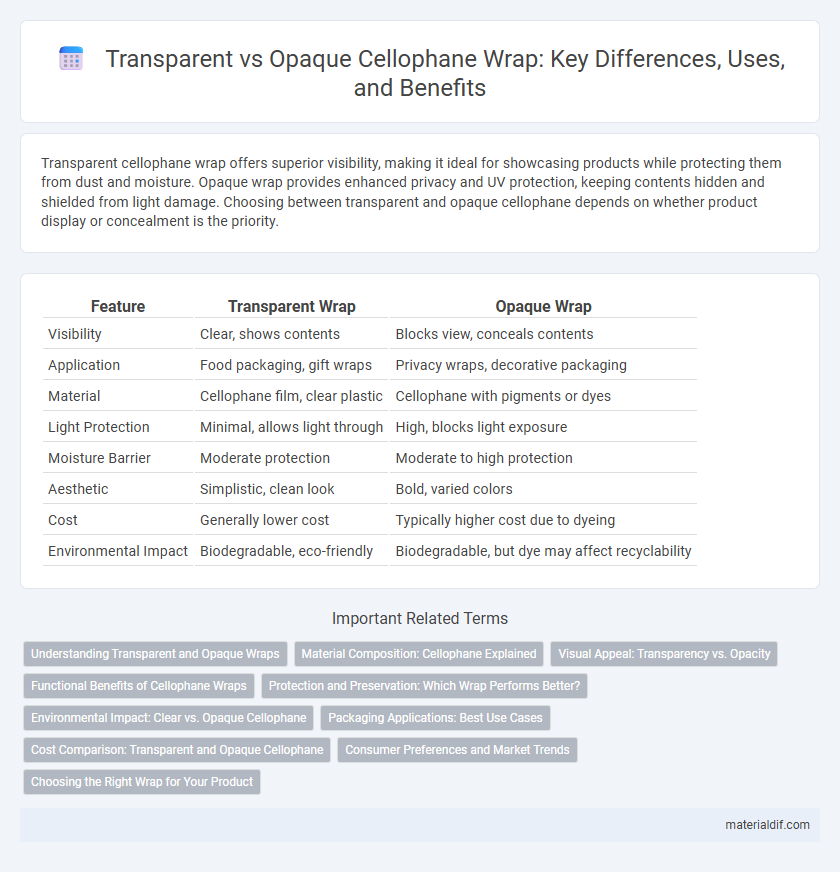Transparent cellophane wrap offers superior visibility, making it ideal for showcasing products while protecting them from dust and moisture. Opaque wrap provides enhanced privacy and UV protection, keeping contents hidden and shielded from light damage. Choosing between transparent and opaque cellophane depends on whether product display or concealment is the priority.
Table of Comparison
| Feature | Transparent Wrap | Opaque Wrap |
|---|---|---|
| Visibility | Clear, shows contents | Blocks view, conceals contents |
| Application | Food packaging, gift wraps | Privacy wraps, decorative packaging |
| Material | Cellophane film, clear plastic | Cellophane with pigments or dyes |
| Light Protection | Minimal, allows light through | High, blocks light exposure |
| Moisture Barrier | Moderate protection | Moderate to high protection |
| Aesthetic | Simplistic, clean look | Bold, varied colors |
| Cost | Generally lower cost | Typically higher cost due to dyeing |
| Environmental Impact | Biodegradable, eco-friendly | Biodegradable, but dye may affect recyclability |
Understanding Transparent and Opaque Wraps
Transparent wrap, commonly made from cellophane or polyethylene, offers clear visibility of the contents inside, making it ideal for packaging food, gifts, and retail products where product presentation is crucial. Opaque wrap, typically produced from materials like waxed paper or colored plastic films, provides privacy and protection from light exposure, extending the shelf life of light-sensitive items. Choosing between transparent and opaque wrap depends on the need for product visibility versus protection from environmental factors such as UV rays and moisture.
Material Composition: Cellophane Explained
Cellophane is a transparent wrapping material made from regenerated cellulose derived from wood pulp, offering biodegradability and breathability. Unlike opaque wraps, which often use plastics or coated papers, cellophane's natural composition allows moisture permeability, making it ideal for food packaging that requires freshness and visibility. Its eco-friendly nature and clarity differentiate it significantly from synthetic opaque alternatives.
Visual Appeal: Transparency vs. Opacity
Transparent wrap offers superior visual appeal by allowing full visibility of the product, enhancing its color, texture, and detail, which attracts consumers through clarity and authenticity. Opaque wrap conceals the contents completely, creating a sense of mystery or luxury but sacrificing immediate product recognition and visual connection. This transparency vs. opacity trade-off significantly influences packaging design choices based on marketing goals and consumer engagement strategies.
Functional Benefits of Cellophane Wraps
Cellophane wrap offers superior breathability and moisture resistance compared to opaque wraps, making it ideal for preserving freshness in food packaging. Its transparency allows for clear product visibility, enhancing consumer appeal and facilitating quality inspection without unwrapping. Unlike opaque wraps, cellophane also provides a natural, biodegradable option that supports sustainable packaging solutions.
Protection and Preservation: Which Wrap Performs Better?
Transparent wrap offers superior visibility, allowing for easy inspection of food freshness without unwrapping, while providing effective protection against moisture and contaminants. Opaque wrap excels in blocking light, which helps preserve food quality by preventing exposure to UV rays that cause spoilage and nutrient degradation. For optimal food preservation, choosing transparent wrap enhances monitoring, whereas opaque wrap extends shelf life by shielding contents from light-induced damage.
Environmental Impact: Clear vs. Opaque Cellophane
Transparent cellophane is often favored for its biodegradability and compostability, as it is typically made from cellulose derived from wood pulp, which decomposes naturally in the environment. Opaque cellophane may contain added pigments or coatings that can reduce its biodegradability and complicate recycling processes. Choosing clear cellophane supports reduced environmental impact through easier integration into composting systems and less chemical processing compared to opaque alternatives.
Packaging Applications: Best Use Cases
Cellophane offers excellent moisture resistance and breathability, making transparent wrap ideal for packaging fresh produce and baked goods where visibility and freshness are crucial. Opaque wrap excels in protecting light-sensitive products such as chocolates and pharmaceuticals, providing barrier properties that extend shelf life and prevent degradation. Choose transparent wrap for marketing purposes that showcase product quality, while opaque wrap suits applications requiring UV protection and enhanced durability.
Cost Comparison: Transparent and Opaque Cellophane
Transparent cellophane generally costs more than opaque cellophane due to its higher manufacturing precision and material clarity requirements. Opaque cellophane is often less expensive as it uses pigments or dyes that reduce material costs and simplify production. Businesses seeking cost-effective packaging solutions frequently opt for opaque wraps to reduce expenses without compromising basic protection.
Consumer Preferences and Market Trends
Consumer preferences in the packaging industry reveal a growing demand for transparent wrap due to its ability to showcase product quality and enhance visual appeal, driving market trends toward clear cellophane materials. Opaque wrap remains favored for privacy and UV protection, appealing to premium brands emphasizing product protection over visibility. Market analytics indicate that transparent wrap dominates retail sectors, particularly in food and gift packaging, reflecting a shift in consumer behavior toward transparency and trust in product presentation.
Choosing the Right Wrap for Your Product
Transparent wrap offers superior visibility, allowing customers to see the product's details and colors clearly, making it ideal for items where appearance drives sales. Opaque wrap provides enhanced protection from light, moisture, and contaminants, preserving product freshness and extending shelf life, especially important for sensitive goods like food or cosmetics. Selecting the right wrap depends on balancing product display needs with preservation requirements to maximize both appeal and quality.
Transparent Wrap vs Opaque Wrap Infographic

 materialdif.com
materialdif.com